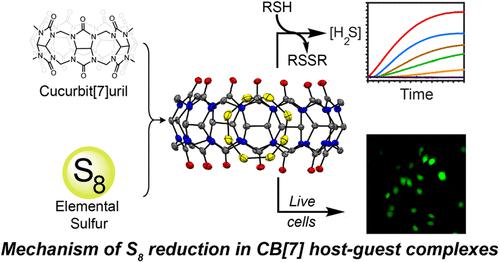当前位置:
X-MOL 学术
›
J. Am. Chem. Soc.
›
论文详情
Our official English website, www.x-mol.net, welcomes your
feedback! (Note: you will need to create a separate account there.)
Supramolecular Activation of S8 by Cucurbiturils in Water and Mechanism of Reduction to H2S by Thiols: Insights into Biological Sulfane Sulfur Trafficking
Journal of the American Chemical Society ( IF 14.4 ) Pub Date : 2022-08-05 , DOI: 10.1021/jacs.2c06332 Arman C Garcia 1 , Lev N Zakharov 1 , Michael D Pluth 1
Journal of the American Chemical Society ( IF 14.4 ) Pub Date : 2022-08-05 , DOI: 10.1021/jacs.2c06332 Arman C Garcia 1 , Lev N Zakharov 1 , Michael D Pluth 1
Affiliation

|
Reactive sulfur species (RSS) play critical roles in diverse chemical environments. Molecules containing sulfane sulfur (S0) have emerged as key species involved in cellular redox buffering as well as RSS generation, translocation, and action. Using cucurbit[7]uril (CB[7]) as a model hydrophobic host, we demonstrate here that S8 can be encapsulated to form a 1:1 host guest complex, which was confirmed by solution state experiments, mass spectrometry, and X-ray crystallography. The solid state structure of CB[7]/S8 shows that the encapsulated S8 is available to nucleophiles through the carbonyl portals of the host. Treatment of CB[7]/S8 with thiols results in efficient reduction of S8 to H2S in water at physiological pH. We establish that encapsulated S8 is attacked by a thiol within the CB[7] host and that the resultant soluble hydropolysulfide is ejected into solution, where it reacts further with thiols to generate soluble sulfane sulfur carriers and ultimately H2S. The formation of these intermediate is supported by observed kinetic saturation behavior, competitive inhibition experiments, and alkylative trapping experiments. We also demonstrate that CB[7]/S8 can be used to increase sulfane sulfur levels in live cells using fluorescence microscopy. More broadly, this work suggests a general activation mechanism of S8 by hydrophobic motifs, which may be applicable to proteins, membranes, or other bimolecular compartments that could transiently bind and solubilize S8 to promote reaction with thiols to solubilize and shuttle S8 back into the redox labile sulfane sulfur pool. Such a mechanism would provide an attractive manifold in which to understand the RSS translocation and trafficking.
中文翻译:

葫芦脲对水中 S8 的超分子活化及硫醇还原为 H2S 的机制:对生物硫磺贩运的见解
活性硫物质 (RSS) 在各种化学环境中发挥着关键作用。含有硫烷硫 (S 0 ) 的分子已成为参与细胞氧化还原缓冲以及 RSS 生成、易位和作用的关键物种。使用葫芦[7]uril (CB[7]) 作为模型疏水主体,我们在此证明 S 8可以被封装形成 1:1 的主体客体复合物,这已通过溶液状态实验、质谱和 X - 射线晶体学。CB[7]/S 8的固态结构表明封装的S 8可通过主体的羰基入口供亲核试剂使用。用硫醇处理 CB[7]/S 8可有效减少 S 8到生理 pH 值的水中的 H 2 S。我们确定封装的 S 8被 CB[7] 主体内的硫醇攻击,生成的可溶性氢多硫化物被喷射到溶液中,在那里它与硫醇进一步反应生成可溶性硫烷硫载体并最终生成 H 2 S。这些中间体得到了观察到的动力学饱和行为、竞争性抑制实验和烷基化捕获实验的支持。我们还证明了 CB[7]/S 8可用于使用荧光显微镜提高活细胞中的硫烷硫含量。更广泛地说,这项工作表明了 S 8的一般激活机制通过疏水基序,这可能适用于蛋白质、膜或其他双分子隔室,它们可以瞬时结合和溶解 S 8以促进与硫醇的反应,以溶解和穿梭 S 8回到氧化还原不稳定的硫烷硫池中。这样的机制将提供一个有吸引力的多方面来理解 RSS 易位和贩运。
更新日期:2022-08-05
中文翻译:

葫芦脲对水中 S8 的超分子活化及硫醇还原为 H2S 的机制:对生物硫磺贩运的见解
活性硫物质 (RSS) 在各种化学环境中发挥着关键作用。含有硫烷硫 (S 0 ) 的分子已成为参与细胞氧化还原缓冲以及 RSS 生成、易位和作用的关键物种。使用葫芦[7]uril (CB[7]) 作为模型疏水主体,我们在此证明 S 8可以被封装形成 1:1 的主体客体复合物,这已通过溶液状态实验、质谱和 X - 射线晶体学。CB[7]/S 8的固态结构表明封装的S 8可通过主体的羰基入口供亲核试剂使用。用硫醇处理 CB[7]/S 8可有效减少 S 8到生理 pH 值的水中的 H 2 S。我们确定封装的 S 8被 CB[7] 主体内的硫醇攻击,生成的可溶性氢多硫化物被喷射到溶液中,在那里它与硫醇进一步反应生成可溶性硫烷硫载体并最终生成 H 2 S。这些中间体得到了观察到的动力学饱和行为、竞争性抑制实验和烷基化捕获实验的支持。我们还证明了 CB[7]/S 8可用于使用荧光显微镜提高活细胞中的硫烷硫含量。更广泛地说,这项工作表明了 S 8的一般激活机制通过疏水基序,这可能适用于蛋白质、膜或其他双分子隔室,它们可以瞬时结合和溶解 S 8以促进与硫醇的反应,以溶解和穿梭 S 8回到氧化还原不稳定的硫烷硫池中。这样的机制将提供一个有吸引力的多方面来理解 RSS 易位和贩运。











































 京公网安备 11010802027423号
京公网安备 11010802027423号